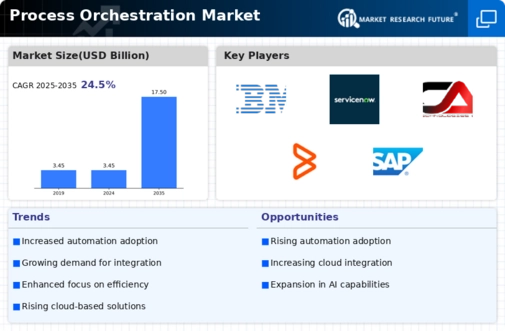Market Growth Projections
The Global Process Orchestration Market Industry is poised for substantial growth in the coming years. Projections indicate that the market will expand from 3.45 USD Billion in 2024 to an impressive 17.5 USD Billion by 2035. This growth trajectory suggests a compound annual growth rate of 15.93% from 2025 to 2035. Such figures reflect the increasing adoption of orchestration solutions across various sectors, driven by the need for enhanced efficiency, automation, and compliance. The market's expansion is indicative of a broader trend towards digital transformation, as organizations seek to optimize their processes and remain competitive in a rapidly evolving landscape.
Increased Demand for Automation
The Global Process Orchestration Market Industry experiences heightened demand for automation across various sectors. Organizations are increasingly recognizing the need to streamline operations and enhance efficiency. Automation not only reduces human error but also accelerates processes, leading to significant cost savings. For instance, industries such as manufacturing and finance are adopting orchestration solutions to automate workflows, resulting in improved productivity. As a result, the market is projected to reach 3.45 USD Billion in 2024, indicating a robust growth trajectory. This trend suggests that businesses are prioritizing automation as a strategic initiative to remain competitive in the evolving global landscape.
Expansion of Cloud-Based Solutions
The expansion of cloud-based solutions is significantly influencing the Global Process Orchestration Market Industry. As organizations increasingly migrate to cloud environments, the demand for orchestration tools that facilitate seamless integration and management of cloud applications is rising. Cloud-based orchestration solutions offer scalability, flexibility, and cost-effectiveness, making them attractive to businesses of all sizes. For instance, enterprises can utilize cloud orchestration to manage multi-cloud environments efficiently, optimizing resource allocation. This trend indicates a shift towards cloud-centric strategies, further driving market growth as organizations seek to leverage the benefits of cloud technology.
Rising Focus on Customer Experience
The emphasis on enhancing customer experience is a pivotal driver in the Global Process Orchestration Market Industry. Organizations are increasingly adopting orchestration solutions to streamline customer interactions and improve service delivery. By automating customer service processes, companies can respond more swiftly to inquiries and resolve issues efficiently. For example, businesses in the retail sector leverage orchestration tools to manage customer orders and inquiries seamlessly. This focus on customer-centric approaches is expected to contribute to the market's growth, with a projected compound annual growth rate of 15.93% from 2025 to 2035. Organizations recognize that superior customer experience is integral to maintaining competitiveness.
Integration of Advanced Technologies
The integration of advanced technologies such as artificial intelligence and machine learning is driving the Global Process Orchestration Market Industry forward. These technologies enable organizations to analyze vast amounts of data, facilitating informed decision-making and optimizing processes. For example, AI-driven orchestration tools can predict bottlenecks and suggest improvements in real-time, enhancing operational efficiency. As companies increasingly adopt these technologies, the market is expected to witness substantial growth, with projections indicating a rise to 17.5 USD Billion by 2035. This integration not only streamlines operations but also positions organizations to leverage data-driven insights for strategic advantage.
Growing Need for Compliance and Risk Management
In the Global Process Orchestration Market Industry, the growing need for compliance and risk management is a significant driver. Organizations are compelled to adhere to stringent regulations and standards, necessitating the implementation of orchestration solutions that ensure compliance across processes. For instance, financial institutions utilize orchestration tools to automate compliance checks and audits, thereby minimizing risks associated with regulatory violations. This trend is likely to propel market growth as companies prioritize risk management strategies. The increasing complexity of regulatory environments suggests that the demand for orchestration solutions will continue to rise, further solidifying the market's expansion.









Leave a Comment